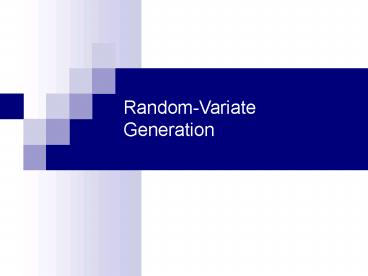Chapter 8: RandomVariant Generation - PowerPoint PPT Presentation
1 / 19
Title:
Chapter 8: RandomVariant Generation
Description:
Illustrate some widely-used techniques for generating random variates. ... number of shipments, x, on the loading dock of IHW company is either 0, 1, or 2 ... – PowerPoint PPT presentation
Number of Views:41
Avg rating:3.0/5.0
Title: Chapter 8: RandomVariant Generation
1
Random-Variate Generation
2
Purpose Overview
- Develop understanding of generating samples from
a specified distribution as input to a simulation
model. - Illustrate some widely-used techniques for
generating random variates. - Inverse-transform technique
- Convolution technique
- Acceptance-rejection technique
- A special technique for normal distribution
2
3
Inverse-transform Technique
- The concept
- For cdf function r F(x)
- Generate R sample from uniform (0,1)
- Find X sample
X F-1(R)
3
4
Exponential Distribution Inverse-transform
- Exponential Distribution
- Exponential cdf
- To generate X1, X2, X3 , generate R1, R2, R3 ,
r F(x) 1 e-?x for x ??0
Xi F-1(Ri) -(1/?? ln(1-Ri)
Figure Inverse-transform technique for exp(? 1)
4
5
Exponential Distribution Inverse-transform
- Example Generate 200 variates Xi with
distribution exp(? 1) - Matlab Code
- for i1200,
- expnum(i)-log(rand(1))
- end
R and (1 R) have U(0,1) distribution
5
6
Uniform Distribution Inverse-transform
- Uniform Distribution
- Uniform cdf
- To generate X1, X2, X3 ,, generate R1, R2, R3 ,
6
7
Uniform Distribution Inverse-transform
- Example Generate 500 variates Xi with
distribution Uniform (3,8) - Matlab Code
- for i1500,
- uninum(i)35rand(1)
- end
7
8
Empirical Continuous Distn Inverse-transform
- When theoretical distribution is not applicable
- To collect empirical data
- Resample the observed data
- Interpolate between observed data points to fill
in the gaps - For a small sample set (size n)
- Arrange the data from smallest to largest
- Assign the probability 1/n to each interval
- where
8
9
Empirical Continuous Distn Inverse-transform
- Example Suppose the data collected for 100
broken-widget repair times are
Consider R1 0.83 c3 0.66 lt R1 lt c4
1.00 X1 x(4-1) a4(R1 c(4-1)) 1.5
1.47(0.83-0.66) 1.75
9
10
Discrete Distribution Inverse-transform
All discrete distributions can be generated by
the Inverse-transform technique.
F(x)
p1 p2 p3
p1 p2
R1
p1
General Form
b
a
c
10
11
Discrete Distribution Inverse-transform
- Example Suppose the number of shipments, x, on
the loading dock of IHW company is either 0, 1,
or 2 - Data - Probability distribution
- Method - Given R, the generation
- scheme becomes
Consider R1 0.73 F(xi-1) lt R lt
F(xi) F(x0) lt 0.73 lt F(x1) Hence, x1 1
11
12
Convolution Technique
- Use for X Y1 Y2 Yn
- Example of application
- Erlang distribution
- Generate samples for Y1 , Y2 , , Yn and then
add these samples to get a sample of X.
12
13
Erlang Distribution Convolution
- Example Generate 500 variates Xi with
distribution Erlang-3 (mean k/???????? - Matlab Code
- for i1500,
- erlnum(i)-1/6(log(rand(1))log(rand(1))log(rand
(1))) - end
13
14
Acceptance-Rejection technique
- Useful particularly when inverse cdf does not
exist in closed form - a.k.a. thinning
- Steps to generate X with pdf f(x)
- Step 0 Identify a majorizing function g(x) and a
pdf h(x) satisfying - Step 1 Generate Y with pdf h(x)
- Step 2 Generate U Uniform(0,1) independent of
Y - Step 3
Efficiency parameter is c
14
15
Triangular Distribution Acceptance-Rejection
- Example
15
16
Triangular Distribution Acceptance-Rejection
Matlab Code (for exactly 1000 samples) i0 while
ilt1000, Yrand(1) Urand(1) if
Ylt0.5 Ult2Y Ygt0.5 Ult2-2Y
ii1 X(i)Y end end
16
17
Normal Distribution Special Technique
- Approach for normal(0,1)
- Consider two standard normal random variables, Z1
and Z2, plotted as a point in the plane - B2 Z21 Z22 chi-square distribution with 2
degrees of freedom Exp(? 1/2). Hence, - The radius B and angle ? are mutually
independent.
??? Uniform(0,2??
In polar coordinates Z1 B cos ? Z2 B sin ?
17
18
Normal Distribution Special Technique
- Approach for normal(?,??)
- Generate Zi N(0,1)
- Approach for lognormal(?,??)
- Generate X N(?,??)
Xi ? ? Zi
Yi eXi
18
19
Normal Distribution Special Technique
- Generate 1000 samples of Normal(7,4)
- Matlab Code
- for i1500,
- R1rand(1)
- R2rand(1)
- Z(2i-1)sqrt(-2log(R1))cos(2piR2)
- Z(2i)sqrt(-2log(R1))sin(2piR2)
- end
- for i11000,
- Z(i)72Z(i)
- end
19































